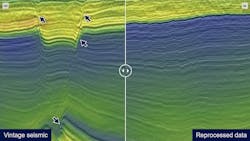PGS provides uplift to North Sea Egersund basin seismic data
Offshore staff
OSLO, Norway – PGS is offering results from a seismic data rejuvenation project for the Egersund basin in the south-western part of the Norwegian North Sea.
The new dataset is said to provide a clearer image of the Jurassic interval for assessment of carbon storage opportunities and risks, and near-field E&P potential.
Until recently, exploration and production was the main attraction of the basin, mainly from the Repsol Norge-operated Yme field. However, the focus is changing following new licenses for carbon storage in the area, which is between the Norwegian-Danish basin and the Stavanger Platform.
Proven Mid-Jurassic reservoir sands in the area are sealed by thick Cretaceous and Jurassic shales. But sharper data were needed, PGS said, for assessing trap geometries and the leakage risk in the overlying sealing rocks in terms of large-scale CO2 storage.
Due to the influence of tectonic structuring and salt movement, high-resolution data with a particular focus on the near-surface were paramount, along with a detailed understanding of fault patterns in the overburden in order to determine the vertical extent and connection to the reservoir target level.
PGS’s rejuvenation program involved broadband reprocessing of seismic acquired in 2005. The new PGS22004EGB data-set is said to provide enhanced data bandwidth at the reservoir target level, with improved signal-to-noise, and better velocity definition in the overburden.
Techniques applied include full 3D de-ghosting, modern 3D de-multiple methods, and 4D-regularization. To develop a more accurate and robust velocity model for the final Kirchhoff pre-stack depth migration, the company employed FWI and reflection tomography.
09.13.2023
